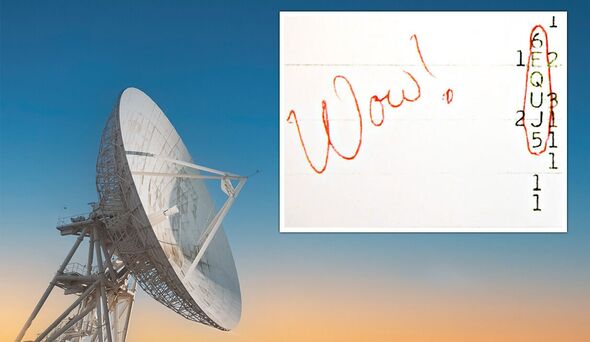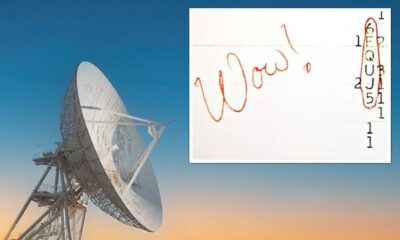Science
Scientists Uncover Natural Source of Cosmic ‘Wow!’ Signal

A long-standing mystery surrounding a radio signal detected nearly five decades ago may have reached a resolution. According to new research, the so-called Wow! signal, first identified on August 15, 1977, may not be evidence of extraterrestrial life but rather a natural astrophysical phenomenon.
The Wow! signal was captured by the Big Ear radio telescope at Ohio State University. Astronomer Jerry Ehman famously noted his surprise by writing “Wow!” on the printout after observing a peculiar 72-second burst at 1420 MHz, the frequency associated with hydrogen, the most abundant element in the universe. Since its detection, the origin of this signal has been a topic of speculation, with theories ranging from comets to alien communication.
A recent study by the Arecibo Wow! Project, led by Professor Abel Mendez of the University of Puerto Rico, proposes a compelling explanation for the signal. Published on August 14, 2025, the research suggests that the signal originated from a powerful astrophysical flare. The team re-analysed over 75,000 pages of archival data, improving upon earlier measurements to determine that the signal was stronger than initially believed, exceeding 250 Janskys and more precisely localised within the constellation Sagittarius.
The researchers attribute the signal to a flare from a magnetar, a highly magnetised neutron star, interacting with a cold interstellar hydrogen cloud. This interaction may have triggered a “maser flare,” a natural amplification of hydrogen emissions akin to a cosmic laser. This explanation addresses the signal’s intensity, narrow bandwidth, and its one-time occurrence.
The study also dismisses potential terrestrial interference from satellites, television transmissions, or solar activity, rejecting earlier hypotheses that comets or reflections from space debris could explain the signal. Past observations from the Arecibo telescope, prior to its collapse in 2020, identified weaker emissions from hydrogen clouds, supporting this new theory.
Yet, some scientists remain cautious. The frequency of hydrogen is still considered a prime candidate for extraterrestrial signals, and previous researchers, including Big Ear director John Kraus, suggested that the Wow! signal was “highly suggestive” of intelligent origins. The recent identification of interstellar comet 3I/ATLAS (C/2025 N1), which is passing through the solar system from the same region of Sagittarius, has added a layer of intrigue, though most astronomers assert that its observed characteristics are typical of comets.
The Wow! signal continues to be a prominent candidate in the search for extraterrestrial intelligence (SETI), although it is not the only one. In 2003, astronomers detected a brief radio burst named “SHGb02+14a” during a SETI survey. More recently, unexplained narrowband signals from Proxima Centauri were investigated in 2020 under the “Breakthrough Listen” initiative. Each of these instances was later determined to likely have natural or terrestrial origins, highlighting the ongoing challenges of differentiating potential alien messages from cosmic background noise.
Professor Mendez noted that the new analysis does not close the case on the Wow! signal but rather “reopens it, with a much sharper map.” The team aims to digitise all Big Ear data by 2027, marking the 50th anniversary of the signal’s detection. Future observational initiatives, such as the Square Kilometre Array, are expected to enhance sensitivity and may ultimately clarify whether the Wow! signal was a rare natural occurrence or something more.
-

 Entertainment3 months ago
Entertainment3 months agoAnn Ming Reflects on ITV’s ‘I Fought the Law’ Drama
-

 Entertainment4 months ago
Entertainment4 months agoKate Garraway Sells £2 Million Home Amid Financial Struggles
-

 Health3 months ago
Health3 months agoKatie Price Faces New Health Concerns After Cancer Symptoms Resurface
-

 Entertainment3 months ago
Entertainment3 months agoCoronation Street’s Carl Webster Faces Trouble with New Affairs
-

 Entertainment3 months ago
Entertainment3 months agoWhere is Tinder Swindler Simon Leviev? Latest Updates Revealed
-

 Entertainment4 months ago
Entertainment4 months agoMarkiplier Addresses AI Controversy During Livestream Response
-

 Science1 month ago
Science1 month agoBrian Cox Addresses Claims of Alien Probe in 3I/ATLAS Discovery
-

 Entertainment4 months ago
Entertainment4 months agoKim Cattrall Posts Cryptic Message After HBO’s Sequel Cancellation
-

 Entertainment3 months ago
Entertainment3 months agoOlivia Attwood Opens Up About Fallout with Former Best Friend
-

 Entertainment6 days ago
Entertainment6 days agoCoronation Street Fans React as Todd Faces Heartbreaking Choice
-

 Entertainment3 months ago
Entertainment3 months agoMasterChef Faces Turmoil as Tom Kerridge Withdraws from Hosting Role
-

 Entertainment4 months ago
Entertainment4 months agoSpeculation Surrounds Home and Away as Cast Departures Mount











